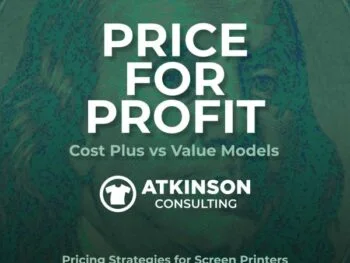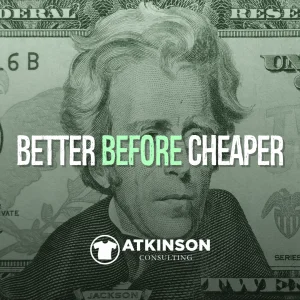Quick question: Can your shop operate with a no excuses mentality?
For the decorated apparel industry, what does that exactly mean anyway? At best, it’s a culture-driven herculean challenge. Worst, it probably means some people you work with might not be the best fit.
For this article, let’s explore what this means and see how it fits into your shop.
No Excuses Sales
For starters, having a no excuses way of looking at things means that the level of personal accountability has to be ratcheted up a few notches. I’ve been around plenty of salespeople that promise the moon, but never deliver.
Sales goals that aren’t achieved.
Information for orders that has to be dragged out of them.
Everything is “last minute” and “do me a favor”. You would think a calendar had never been invented.
Let’s say that Bill is a salesman for your shop. He’s always talking about doing something “later” or “tomorrow”, but doesn’t seem to get around to completing those tasks on time. Let alone early. Bill is constantly underperforming when we look at his sales goals.
But when you talk to Bill, he always complains about the same things:
- He’s busy doing other things in the shop. Posting on social media. Writing reports. Delivering orders. Anything but his primary focus sales duties.
- Bill says he needs more qualified leads. The ones that come in he can’t always use, or they don’t pan out for some reason.
- His pipeline “just has to convert”. Bill has been talking to a lot of folks, but the timing is never right for them to get that order in. Next week is the common refrain.
- “Our shop is too expensive”. This is code for “I can’t demonstrate our value to the customer”. To get the sale, Bill pushes the shop into some difficult situations financially.
- “No one is getting back to me!” It is usually the customer’s fault that the communication isn’t working.
- “That bigger shop gets all the business”. This one is Bill’s favorite, and he whips it out and discourages himself constantly.
So if you were Bill’s manager, how can you eliminate these excuses from Bill’s daily vocabulary?
Clarify
One thing that has to be handled is to clarify what is job number one for Bill. Can you describe what success looks like for him? Have you outlined what exactly are his key duties and the best type of customer to target?
A lot of this comes from writing a business plan. If you don’t have one, how are you giving Bill his marching orders on who to call that’s the best fit for your company?
When Bill wastes his time with customers that will never buy, that isn’t doing him or your shop any favors. Clarify the type of customer that makes sense. It is a waste of his time to book and manage a 12 piece family vacation order for someone he’ll never see again. His fish swim in a deeper part of the ocean.
Build a brand persona describing their activity, sales dollars, frequency and timing for ordering and other factors. Who makes the buying decisions?
What Bill really needs is alignment with the customer base that absolutely craves what you do. Sure, that’s difficult to narrow down and describe, but once that’s worked out Bill will have an easier time selling as a good number of the usual objections won’t be in the picture. Data and research will carve out that target for Bill.
Help
Your sales team needs support. This includes education and training. Knowledge about the industry. Creative assets they can use. Technology and equipment. Not to mention time.
Help them help you.
The more time Bill takes doing anything but selling, the lower his total will be at the end of the month. So if Bill is in charge of filming cute short little videos about your shop to post on Instagram, don’t be surprised if he isn’t hitting a daily sales goal.
For some shops, there simply isn’t enough people to go around for all the tasks. I get it. However, there are plenty of outsourcing teams that can handle some of these chores for you.
“No excuses” mean protecting and prioritizing time. Sure, that social media post has to be created. But does Bill have to be the one to handle that task?
Think things through.
Prioritize
What’s more important?
Bringing in more orders and establishing relationships with potential and current clients, or having Bill run that 36 piece order across town because “nobody else can do it”.
My point here is that for a lot of shops, they prioritize the wrong things sometimes. Make better decisions.
For starters, maybe that job could be shipped UPS or USPS and arrive tomorrow? Maybe someone else could take it after work?
And if he absolutely “has to” take that box, can he turn that into a good selling opportunity by cold calling a half dozen other potential customers too?
You have to prioritize what’s more valuable for Bill’s time. Remember, either you will find a way, or you will find an excuse.
Don’t let it be an excuse.
No Excuses Production
So in your shop do you have the constant finger pointing battle between sales and production?
It is the most common source of drama in the industry. The problem stems from both parties not understanding either viewpoint and working together to resolve their challenges. Finger pointing and excuse making is more fun.
Here’s a cold hard fact.
It is not anyone’s fault if something goes wrong. It’s the entire companies. Everyone owns it.
Working together as a team is the only way to achieve more success.
That means the front office (sales, purchasing, and art/digitizing) has to work perfectly with the back end of the shop (receiving, production, post-production, and shipping).
Remember, you can only move as fast as the slowest part of your process. In your shop, can you name that speedbump? Are you keeping track of your top ten challenges you have been facing?
Exactly what is your plan to resolve them? How’s that going?
I say this because typically nothing is in the works to solve these challenges. I know you know this, but sometimes the daily grind obscures this fact…this is a craftsmanship, information-driven, detail-focused industry. Literally, hundreds of steps have to be completed before the customer can hold up that shirt and say, “That looks great!”.
Each one of those steps is an opportunity to succeed or stub our toe.
Dialing It In
Think about it. Have you mapped out your process?
What is step one for an order? Probably getting that quote approved and the information entered into the system. But when that information is incomplete or wrong, the people downstream from that are using what’s entered to make often wrong decisions. A huge chunk of production problems occurs not from technique, but from the information on the order.
If you do one thing this week to improve your shop look into ways you can make things easier for production to be more successful with how they interpret information.
Standardize many of your common tasks and steps. Spend more time preventing excuses by supplying people with an abundance of information.
For example, on your art approvals or mockups are you detailing the print order? How many inches down from the collar? The center point on the embroidery file? Showing the decoration not only in color but on every color shirt for the order?
What happens for different styles of shirts too? On that V-neck women’s tee where does the left chest print go in relation to the bottom of the V? Trust me, if you print too low on a women’s shirt that order is coming back.
A no excuses mentality is about thinking things all the way through. You aren’t letting your production person determine placement. It’s discussed in advance. Illustrated with dimensions on that mockup or art approval, like a blueprint. With training and communication, execution of the plan for the customer becomes easy.
No Excuses Tuition
Every time there is a mistake in your shop is someone learning from that?
Mistakes are going to happen. I make them. You make them. Everyone makes them.
When someone goofs up and prints on the wrong side of the shirt are you using that to strengthen your process somehow? Maybe saving a shirt and holding it up as a discussion topic on quality control? Digging in with a Kaizen event to determine how the mistake was made so you can engineer the process a little bit further?
Sure, we all feel bad when something goes wrong. It can get expensive too.
That error is essentially the tuition you pay to improve.
Some shops will make a mistake and shrug their shoulders and nothing happens. Two months from now, another batch of shirts gets ruined from the same mistake. After the forehead slap and subsequent bruising of the ego, you learn the hard way that something has to change.
Or, you can not accept an excuse for why that happened. Insist on change. Bring your team together and share ideas. Talk about what happened. Walk around. Take pictures. Use examples. Brainstorm up a hypothesis that “just might work”.
Then test that sucker.
Did it make a difference?
Yes?
Great!
No? Back to the drawing board. Tweak it until you are satisfied.
But whatever you do, don’t offer up a lame excuse that points a finger somewhere else.
You own it.
“It’s not what you preach, it’s what you tolerate.” – Jocko Willinek
“An excuse is worse and more terrible than a lie, for an excuse is a lie guarded.” – Pope John Paul II
“We excuse our sloth under the pretext of difficulty.” – Quintilian
Need Help With Your Workflow?

Sometimes you need a kick in the pants to get more work out the door. This eBook is that shoe.
Learn how some of the top shops in this industry have built and organized their workflow to achieve higher levels of productivity. In this Free eBook, I guide you through with ten workflow tips that might make a difference for your shop.
Download this eBook today and get started improving your shop!
[av_button label=’Download’ link=’manually,https://atkinsontshirt.com/product/top-10-workflow-tips/’ link_target=’_blank’ size=’x-large’ position=’left’ label_display=” icon_select=’no’ icon=’ue800′ font=’entypo-fontello’ color=’theme-color’ custom_bg=’#444444′ custom_font=’#ffffff’ av_uid=’av-jfmv8l’ admin_preview_bg=”]





